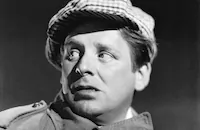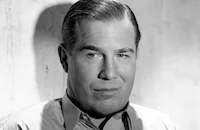Then she caught the eye of Paul Bern, assistant to MGM production chief Irving Thalberg. He saw something in Harlow that nobody else had and tried to generate interest in her at the studio. She had already played the female lead in a suspense thriller there, The Secret Six (1931). When MGM decided to try to cash in on the new gangster genre, he got the studio to hire Harlow to play a gangster's moll who seduces the police commissioner's brother to keep her gangster boyfriend out of jail.
Only Harlow wasn't having it. Bern had promised her that working at MGM would lead to better roles, and here he was offering her more of the same. She stormed into his office to tell him off, and then broke down in tears. He finally convinced her that this was her chance to show his bosses that she could be a good team player. The roles she wanted would come later, after she'd proven her worth to the studio in The Beast of the City (1932).
And Harlow did just that. She had a lot of help from director Charles Brabin, who knew how to get the best out of disenchanted sex symbols. Brabin had directed two of silent screen siren Theda Bara's last films at a time when she was trying to shed her image as a vamp. The image change had failed, but the relationship hadn't. They married shortly afterwards and would stay married for over three decades during which she became one of Hollywood's leading hostesses. He was the first director to spend time helping Harlow develop a performance, and the work showed on screen. For the first time, critics singled her out for more than just her looks, paying particular attention to the scene in which she seduces police commissioner Walter Huston's brother. MGM chief Louis B. Mayer took notice and bought Harlow's contract from Hughes for $60,000. She was finally on her way to the top.
Unfortunately, Mayer didn't look as highly on the film itself. The Beast of the City seemed the perfect MGM gangster saga. In entering the genre, they had gone for the best, hiring W.R. Burnett, author of the novel Little Caesar, to write the screen story. Drawing on tales about the Chicago mob and plot developments from his western novel St. Johnson, Burnett focused his story not on the gangsters, but on an honest cop suddenly elevated to police commissioner status. He tries to take on a mobster modeled on Al Capone, only to have the case threatened by his own brother. Burnett even gave the commissioner a squeaky clean home life, complete with a precocious son who would be played by Mickey Rooney, in his first MGM feature.
But even with its law and order focus, The Beast of the City was too much for MGM, the home of family entertainment. Shocked at the film's violence, Mayer ordered it played off on the bottom half of double bills.
Producer: Hunt Stromberg
Director: Charles Brabin
Screenplay: John Lee Mahin
Based on a story by W.R. Burnett
Cinematography: Norbert Brodine
Art Direction: Cedric Gibbons
Music: Johannes Brahms
Principal Cast: Walter Huston (Jim Fitzpatrick), Jean Harlow (Daisy), Wallace Ford (Edward Fitzpatrick), Jean Hersholt (Sam Fitzpatrick), Tully Marshall (Michaels), John Miljan (District Attorney), J. Carrol Naish (Cholo), Nat Pendleton (Abe Gorman), Mickey Rooney (Mickey Fitzpatrick).
BW-87m. Closed captioning.
by Frank Miller






























